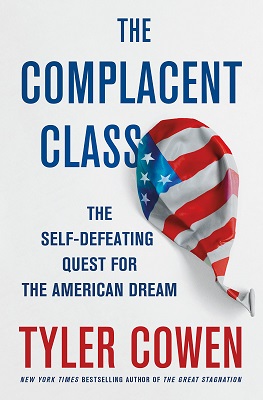Complacent or Pathological?
By Arnold Kling

They have made us more risk averse and more set in our ways, more segregated, and they have sapped us of the pioneer spirit that made America the world’s most productive and innovative economy. Furthermore, all this has happened at a time when we may need American dynamism more than ever before.
—Tyler Cowen, The Complacent Class: The Self-Defeating Quest for the American Dream1
In his latest book, Tyler Cowen documents trends of increased risk aversion, resistance to change, and reluctance to interact with people outside of our familiar groups. He speculates on many plausible causes of these trends, but he does not focus on any single factor. Indeed, in the passage quoted above, “They” refers not to any group or institution, but instead to “people making decisions,” meaning everyone.
The Complacent Class is difficult to summarize. As I write this, over a half dozen reviews have appeared, and each stresses a completely different aspect of the book. This could reflect the great variety of interesting insights that are sprinkled throughout on various topics, or it could reflect a weakness in terms of central focus. Or both.
For me, the strongest chapter is called “The reemergence of segregation.” It hammers home the point that America has become highly segregated by income, educational attainment, and race.
The new segregation is superficially based on economics but more deeply rooted in a culture of matching—rich to rich and well educated to well educated—and a culture of stasis.
For example, Cowen writes,
… historically black neighborhoods within Vienna and Fairfax are gone. In the case of Fairfax, that old convenience store has been replaced by a shiny new mini-mall with a bright pizza restaurant, a Vietnamese pho restaurant, and a gourmet market and deli…
I remember that in the 1960s, as the newly-created Department of Housing and Urban Development touted “urban renewal,” cynics charged that “urban renewal equals black removal.” This has turned out to be the case in many gentrified locations. As Cowen points out,
To be sure… these black neighbors were not forced out. No KKK member burned a cross on these lawns, and non discriminatory laws were passed… Blacks have not been pushed out, but many of them have been priced out.
Cowen finds the highest degree of class segregation in some surprising places.
Durham-Chapel Hill, Bloomington, and Ann Arbor—all college towns—climb into the top five for segregation of the working class away from the non-working class. That is again the somewhat incestuous self-clustering of the complacent class rearing its head.
In one of many powerful passages on this topic, Cowen writes,
… the so-called creative class is more clustered than the working class. Ironically, it’s these groups—the wealthy, the well educated, the creative class—who often complain about inequality and American segregation with the greatest fervor. The self-selection process is running its course, and how people are voting with their feet often differs from what is coming out of their mouths.
Cowen lists a number of adverse consequences of the reemergence of segregation, including,
… more intense sorting along political lines, so that both Democrats and Republicans will be more likely to live in communities of politically like-minded individuals… a disproportionate share of liberals have decided they wish to live in cities… peer effects make cities more liberal and suburban and rural areas more conservative, and thus Americans are all the more tightly sorted.
This tight sorting was highlighted by Christopher Caldwell in an analysis of the 2016 Presidential election.
Washington, D.C., with its 93-to-4 partisan breakdown, is not that unusual. Hillary Clinton won Cambridge, Massachusetts, by 89 to 6 and San Francisco by 86 to 9. Here, where the future of the country is mapped out, the “rest” of the country has become invisible, indecipherable, foreign.2
“Cowen offers a number of indicators of reduced dynamism in the United States, including a reduced rate of new business formation and of long-distance moves by households. However, as he points out, there are many plausible causal factors at work in these phenomena, and not all of them reflect a culture of complacency.”
Cowen offers a number of indicators of reduced dynamism in the United States, including a reduced rate of new business formation and of long-distance moves by households. However, as he points out, there are many plausible causal factors at work in these phenomena, and not all of them reflect a culture of complacency.
Concerning long-distance moves, for example, I think it is important to discuss “collective” moves and individual moves. Individual households move for idiosyncratic reasons, such as a new job. However, many of the largest migrations in history have involved collective moves. Many people from one village will over a short period of time move to a new location, where they cluster together again. We saw this happen historically with the first European settlers in America, with the Irish, Italian, and Jewish immigrations, with the Mormon migration in the late 1800s, with the Okies in the 1930s, and with the African-American migration to the North in the 1940s and 1950s.
Collective migrations tend to be carried out by people who are near the bottom of the social order or otherwise are desperate to escape. Individual moves tend to be carried out by people who are higher up the scale. If the decline in overall moves in recent decades reflects a drop in the incidence of desperation, which does not indicate a lack of dynamism. And in fact, Cowen makes a point of suggesting that the U.S. is still highly mobile if one accounts for the behavior of Mexican immigrants, which would indicate that the desperation motive has not lost its power.
Concerning new business formation, Cowen points out that
Some of the larger declines in dynamism, as identified by the rate of business turnover, have come in the construction, mining, retail, wholesale, and services sectors… the shops in the town square don’t turn over as rapidly as they used to; some of this slowdown stems from the ongoing supplanting of mom-and-pop stores by major chains
Indeed, if you think of the type of business that someone might have started in, say, 1960, a drug store or small grocery in a small or mid-sized town comes to mind. If contemporary Americans are reluctant to attempt such businesses today, who can blame them for not wanting to take on Wal-Mart?
I have only alluded to some of the compelling statistics, interesting observations, and provocative hypotheses that can be found in The Complacent Class. But let me turn to a problem that I had with the book.
I was not satisfied with Cowen’s treatment of the key concept of complacency. He defines it only in a single offhand clause as “a general sense of satisfaction with the status quo.”
However, his use of the term often strays from this definition. I would argue that what he really means is something like “risk aversion and resistance to change.”
For more on these topics, see the EconTalk podcast episodes Cowen on Inequality, the Future, and Average is Over, Cowen on the Great Stagnation, and Burkhauser on the Middle Class.
It is possible to be unsatisfied with the status quo and yet be averse to risk and resistant to change. Cowen himself says as much. He includes in his “complacent class” not just the upper crust of the wealthy but also two other categories, which he calls “those who dig in” and “those who get stuck.” The former have a lot of their wealth in the form of occupational licenses or real estate, which they seek to protect in ways that reduce dynamism. The latter are the dysfunctional poor, and Cowen himself says that “they are not happy with their situations.”
The conceptual imprecision gets Cowen really tangled up in his final chapter on current conditions in the United States and prospects for a sudden increase in instability. On the one hand, he offers poll results indicative of general dissatisfaction with the status quo, and he associates this public angst with the strong support given to Presidential candidates Bernie Sanders and Donald Trump. Yet he writes,
… those who voted for Donald Trump in the Republican primaries… had an average income of about $70,000 and also education levels higher than the American average… Whether we like it or not, the rise of Trump is centered fundamentally on the complacent class.
Again, I think that this shows that there is an important category of people who are dissatisfied with the status quo and at the same time are averse to risk and to change. It is an interesting pathology, but I think it is misleading to term it complacency.
Cowen, Tyler. The Complacent Class: The Self-Defeating Quest for the American Dream. St. Martin’s Press, 2017
“Sanctimony Cities”, by Christopher Caldwell. Claremont Review of Books, January 31, 2017.
*Arnold Kling has a Ph.D. in economics from the Massachusetts Institute of Technology. He is the author of several books, including Crisis of Abundance: Rethinking How We Pay for Health Care; Invisible Wealth: The Hidden Story of How Markets Work; Unchecked and Unbalanced: How the Discrepancy Between Knowledge and Power Caused the Financial Crisis and Threatens Democracy; and Specialization and Trade: A Re-introduction to Economics. He contributed to EconLog from January 2003 through August 2012.
For more articles by Arnold Kling, see the Archive.

